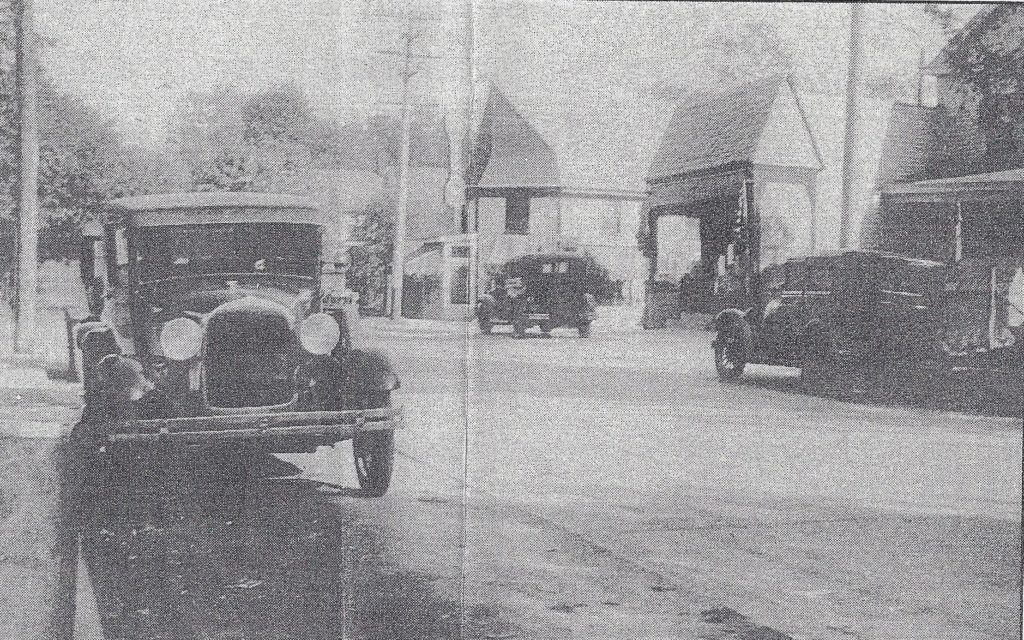By Regina Villiers. Originally published August 25, 1993 in The Suburban Life, added August 15, 2017.

Early Model A Ford cars sit parked on the corner of Miami and Laurel avenues in Madeira around 1930. Adrien’s Pharmacy sits on the left today and Bank One is located on the right corner of the location in the picture.
When Brownie Morgan, as a teenager, first worked on the farms of Blaine DeMar, he learned about the value of the hors and the mule and their roles in getting work done. He also learned about their roles in transportation.
Before cars, horses were the only means of getting from place to place other than the trains that were available.
You could jump on a horse or mule and ride it wherever you wanted to go. You could hitch horses to a carriage or a buggy and take the whole family along. Or farmers and common folk would simply hitch their team of work mules to a wagon and go into town on Saturdays or to church on Sundays.
Brownie got one ride he’ll never forget in a homemade sulky owned by Charles Osher, who worked full time on the DeMar farms. Osher also owned an ex-race horse that pulled the sulky.
One day at quitting time Osher offered Brownie a ride from the Kugler Mill Road farm to Camargo Pike on his way home. Brownie eagerly accepted. It would beat walking home. Besides, he wanted to see how the old racehorse would perform.
Brownie was just a bit skeptical about the sulky, however. It consisted merely of two buggy wheels held together by a length of 12-inch wide board for a seat. They had to ride across a bumpy rye field, which came to be known later as Osceola Park. Brownie wasn’t sure he could stay on the sulky at full speed.
But the sulky survived the bumpy ride and Brownie hung on. The horse loved speed and Osher encouraged it to the fullest. The bond between horse and man that day was much like that between Tom Mix, William S. Hart and their horses, which Brownie had observed o the silent screen in Oakley. It was a thrilling ride, one that Brownie likes to remember to this day.
In Brownie’s early days on the DeMar farms, all farming was done with horses and mules. There were some tractors being used on mammoth spreads out west, but they were too cumbersome and expensive to be used on smaller farms.
But Henry Ford changed all that. He invented the Fordson tractor and started mass production. The pneumatic tire was introduced in 1932. That, combined with the invention of hydraulic control implements in 1936, sealed the fate of the horse, Brownie says. And the horse was abandoned for farm work.
Blaine DeMar bought one of the Fordson tractors while Brownie still worked for him. Brownie enjoyed using it for disking and harrowing the fields. It was fun for a kid his age to drive anything mechanical.
Mr. DeMar also owned one of the first Model T Ford trucks and Brownie learned to drive it.
Brownie describes the truck as looking as if it had been copied from a buggy of the era. The truck was small he says, with a short bed on the back.
The truck had to be crank-started, as did all early cars and machines. It was absolutely necessary to do the cranking properly or risk a broken arm.
First, Brownie says, you had to set the spark lever on the steering wheel in the correct position. You learned to do this through a combination of experiences and guessing.
Second, he says you never ever included the thumb when wrapping the hand around the crank. Too much spark and forgetting the rule of thumb was risky business. The engine could give a mighty kick.
As a result, Brownie says that boys often came to school in those days with their arm in slings.
Mrs. DeMar’s parents owned one of the early cars and would sometimes drive from their home on Erie Avenue to visit the DeMars in Madeira.
The car was a Dodge Brothers touring car with removable side curtains. It was black, the typical color of the era. Cars had no heaters then, so in cooler weather, they used a lap robe, a blanket for touring, in order to keep from freezing.
Brownie then lived through a transition period when the automobile was no longer an oddity. Nor was the horse a prominent means of transportation.
Brownie is not certain when his former boss died. He remembers that he and Helen, his wife, attended the DeMar funeral at Thomas Funeral Home. He thinks it was sometime in the 1950’s.
Brownie has many fond memories of those early days and of Mr. DeMar. “He was a fine man and a good boss,” he says. “His family treated me well.”